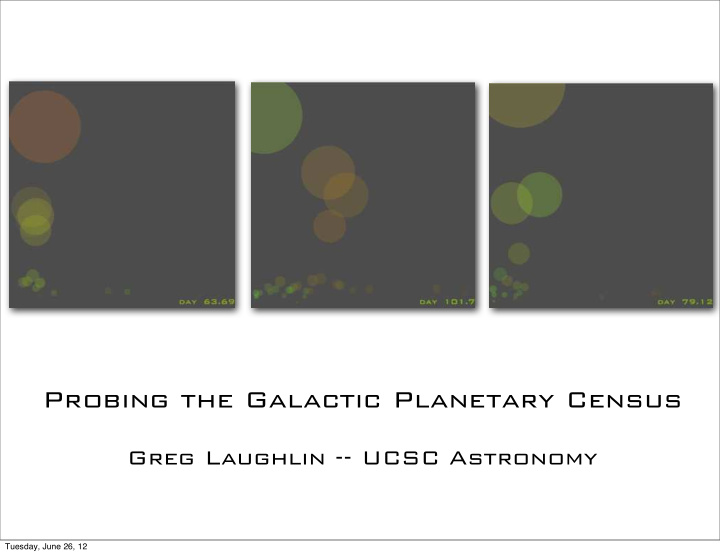



Probing the Galactic Planetary Census Greg Laughlin -- UCSC Astronomy Tuesday, June 26, 12
Exoplanet News “The finding was called ‘exciting’ by from the AAS Dr. Kenneth Franklin of the American Museum-Hayden Planetarium. He meeting noted, however, that Barnard’s Star b (New York Times) probably does not bear life as Earth knows it because the new planet is too large and too cold.” “The discovery of a planet, not much larger than Jupiter, outside the solar system was reported yesterday by a Swarthmore College scientist at an American Astronomical Society meeting.” “The object is a dark companion of a dim star some 36,000,000,000,000 miles away. It is called Barnard’s star” “The new finding adds support to the conviction of astronomers that a great many solar systems exist, some of them possibly supporting life.” Tuesday, June 26, 12
A Planetary System Orbiting Barnard’s Star? New York Times, April 19, 1963 Tuesday, June 26, 12
Credit: ESO (VLT/NACO) Tuesday, June 26, 12
Tuesday, June 26, 12
A stellar spectrum from The Keck Telescope. The velocity of the star along the line of sight is obtained by very accurately measuring the positions of the stellar absorption lines relative to a set of reference lines created by passing the light through an iodine cell which is at rest with respect to the telescope. Tuesday, June 26, 12
50 m/s RV prediction from the van de Kamp (1969) system 2006 1998 -50 m/s Tuesday, June 26, 12
10 UVES Velocity (M/S) 5 0 -5 Radial -10 Signal that would be produced by a 3-Earth mass planet on a 80-d orbit. (Currently, there is no strong evidence for any planets orbiting Barnard’s Star.) HET 1997 1999 2001 2003 2005 2009 2011 2007 Tuesday, June 26, 12
A star and its planetary system forms when an interstellar cloud of gas and dust collapses under its own weight to form a “protostar” surrounded by a spinning disk. Tuesday, June 26, 12
Hubble Space A computer simulation Telescope image Tuesday, June 26, 12
Tuesday, June 26, 12
Ice Giants Terrestrial Planets Icy Outer “Dwarf Planets” Gas Giants Tuesday, June 26, 12
Migration Tuesday, June 26, 12
90 deg KOZAI inclination from plane CYCLES Kozai Cycles with Tidal Friction 39 deg 2(longitude of periapse) hi e hi i End State If we neglect the mass of the planet, then As the orbit shrinks, GR precession eventually the planet conserves destroys the Kozai oscillations, leaving the planet during its motion. (This Kozai integral is related marooned in its high-e state. The orbit gradually to the Jacobi energy and the Tisserand relation circularizes, eventually leaving a hot Jupiter. in the circular restricted 3-body problem.) Tuesday, June 26, 12
The first extrasolar planet around a sun-like star was discovered by Michel Mayor and Didier Queloz in 1995. They measured the Doppler radial velocity of the star. Tuesday, June 26, 12
Tuesday, June 26, 12
23-year Timeline of 55 Cancri RV Observations 55Cnc b discovered (Marcy & Butler 1997) f discovered (2005) e discovered (2005) c, d discovered HET RVs 2/20/1989 (2002) First published Lick RV e revised (2010) Elodie RVs Lick RVs Gliese 229b 51 Peg b discovered discovered RV method affirmed Kepler HD 209458b Launched 1995 2000 1990 2005 2010 Tuesday, June 26, 12
A 14d + 44d + 260d + 5200d fit to the 2+ decades of RV data for 55 Cancri Winn et al. (2011) 0.74d 2.8d (alias) Dawson & Fabrycky (2010) Tuesday, June 26, 12
Saturn (to scale) Tuesday, June 26, 12
Transit of Venus Tuesday, June 26, 12
Planets detected via RV (including transiting planets) Jupiter Earth Tuesday, June 26, 12
Recommend
More recommend